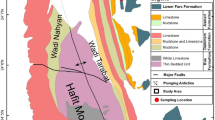Abstract
The development of some predictive models for the geomechanical properties of fault breccias will be useful for geo-engineers, because the preparation of smooth specimens from the fault breccias is usually tedious and expensive. In this study, simple and multiple regression analysis were applied to the data pertaining to Misis Fault Breccia to develop predictive models for the differential stress (Δσ) from non-destructive methods including the Cerchar abrasivity index (CAI). As a result of simple regression analysis, strong relations between Δσ and indirect properties were not found. The CAI was included in the best multiple regression model for the prediction of Δσ. The significance of derived models was statistically tested. It was concluded that the CAI is a useful property for the prediction of Δσ of Misis Fault Breccia.






Similar content being viewed by others
References
Al-Ameen SI, Waller MD (1994) The influence of rock strength and abrasive mineral content on the Cerchar Abrasive Index. Eng Geol 36:293–301
Alber M, Kahraman S (2009) Predicting the uniaxial compressive strength and elastic modulus of a fault breccia from texture coefficient. Rock Mech Rock Eng 42:117–127
Buergi C, Parriaux A, Franciosi G, Rey J-Ph (1999) Cataclastic rocks in underground structures—terminology and impact on the feasibility of projects (initial results). Eng Geol 51:225–235
Chester FM, Logan JM (1986) Implications for mechanical properties of brittle faults from observations of the punchbowl fault zone, California. Pure appl Geophys 124:79–106
Choi SC (1978) Introductory statistics in science. Prentice-Hall Inc, New Jersey
Ehrbar H, Pfenniger I (1999) Umsetzung der Geologie in technische Massnahmen im Tavetscher Zwischenmassive Nord. In: Loew S, Wyss R (eds) Vorerkundung und Prognose der Basistunnels am Gotthard und am Lötschberg. Balkema, Rotterdam, pp 381–394
Evenden MP, Edwards JS (1985) Cutting theory and coal assessment techniques and their application to shearer design. Min Sci Technol 2:253–270
Goodman RE, Ahlgren CS (2000) Evaluating safety of concrete gravity dam on weak rock: Scott Dam. J Geotech Geoenviron Eng 126:429–442
Habimana J, Labiouse V, Descoeudres F (2002) Geomechanical characterisation of cataclastic rocks: experience from the Cleuson–Dixence project. Int J Rock Mech Min Sci 39:677–693
Haneberg WC (2004) Simulation of 3-D block populations to characterize outcrop sampling bias in block-in-matrix rocks (bimrocks). Felsbau Rock Soil Eng 22:19–26
Kahraman S, Alber M (2006) Estimating the unconfined compressive strength and elastic modulus of a fault breccia mixture of weak rocks and strong matrix. Int J Rock Mech Min Sci 43:1277–1287
Kahraman S, Alber M, Fener M, Gunaydin O (2008) Evaluating the geomechanical properties of Misis Fault Breccia (Turkey). Int J Rock Mech Min Sci 45:1469–1479
Kahraman S, Gunaydin O, Alber M, Fener M (2009) Evaluating the strength and deformability properties of Misis Fault Breccia using artificial neural networks. Expert Syst Appl 36:6874–6878
Kahraman S, Alber M, Fener M, Gunaydin O (2010) The usability of Cerchar abrasivity index for the prediction of UCS and E of Misis Fault Breccia: regression and artificial neural networks analysis. Expert Syst Appl 37:8750–8756
Laws S, Eberhardt E, Loew S, Descoeudres F (2003) Geomechanical properties of shear zones in the Eastern Aar Massif, Switzerland and their implication on tunnelling. Rock Mech Rock Eng 36:271–303
Lindquist ES, Goodman RE (1994) Strength and deformation properties of a physical model melange. In: Nelson PP, Laubach SE (eds) Proceedings of the 1st North American rock mechanics symposium. Balkema, Rotterdam, pp 843–850
Medley EW (1994) The engineering characterization of melanges and similar block-in-matrix rocks (bimrocks). Ph.D. Dissertation, University of California at Berkeley, California, UMI, Inc, Ann Arbor, MI
Medley EW (1997) Uncertainty in estimates of block volumetric proportions in melange bimrock. In: Marinos PG, Koukis GC, Tsiambaos GC, Stournaras GC (eds) Proceedings of the international symposium on engineering geology and the environment. Balkema, Rotterdam, pp 267–272
Medley EW (2001) Orderly characterization of chaotic Franciscan Melanges. Felsbau Rock Soil Eng 19:20–33
Medley EW (2002) Estimating block size distribution of melanges and similar block-in-matrix rocks (bimrocks). In: Hammah R, Bawden W, Curran J, Telesnicki M (eds) Proceedings of the 5th North American rock mechanics symposium. University of Toronto Press, Toronto, pp 509–516
Medley EW, Goodman RE (1994) Estimating the block volumetric proportions of melanges and similar block-in-matrix rocks (bimrocks). In: Nelson PP, Laubach SE (eds) Proceedings of the 1st North American rock mechanics symposium. Balkema, Rotterdam, pp 851–858
Schiff D, D’Agostino RB (1995) Practical engineering statistics. Wiley, NewYork
Slatalla N, Alber M, Kahraman S (2010) Analyses of acoustic emission response of a fault breccia in uniaxial deformation. Bull Eng Geol Environ 69:455–463
Sonmez H, Gokceoglu C, Tuncay E, Medley EW, Nefeslioglu HA (2004) Relationship between volumetric block proportion and overall UCS of a volcanic bimrock. Felsbau Rock Soil Eng 22:27–34
Sonmez H, Gokceoglu C, Medley EW, Tuncay E, Nefeslioglu HA (2006) Estimating the uniaxial compressive strength of a volcanic bimrock. Int J Rock Mech Min Sci 43:554–561
Acknowledgments
This study was supported by the Alexander von Humboldt Foundation.
Author information
Authors and Affiliations
Corresponding author
Rights and permissions
About this article
Cite this article
Kahraman, S., Alber, M., Gunaydin, O. et al. The usability of the Cerchar abrasivity index for the evaluation of the triaxial strength of Misis Fault Breccia. Bull Eng Geol Environ 74, 163–170 (2015). https://doi.org/10.1007/s10064-014-0618-4
Received:
Accepted:
Published:
Issue Date:
DOI: https://doi.org/10.1007/s10064-014-0618-4




